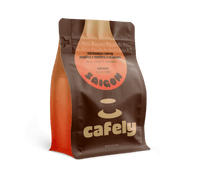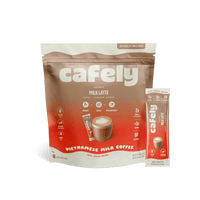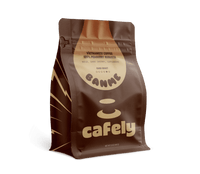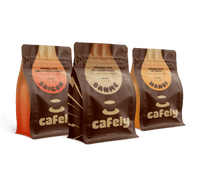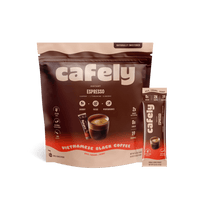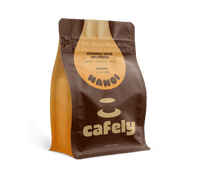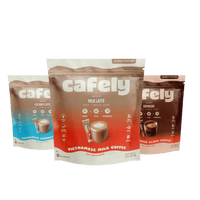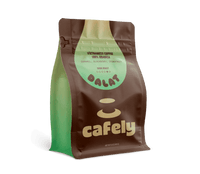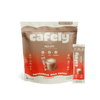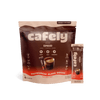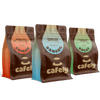While matcha and coffee both contain caffeine, matcha has less caffeine. A typical 8-oz (240 mL) cup of matcha contains 40 to 80 mg of caffeine, whereas the same volume of coffee contains 80 to 100 mg.
However, the exact amount of caffeine varies depending on the type of coffee, the amount of matcha powder used, and even the brewing method.
Read on to learn more about the caffeine content in matcha and coffee, the effects that each has on your energy levels, different brewing methods, and more…
What is Matcha?

Matcha is a green tea powder that’s made by finely grinding up green tea leaves. Shade-grown tea leaves are used, which helps to contribute to the bright green color and unique flavor that matcha provides.
It’s a popular alternative to coffee and has a unique flavor that combines subtle grassy and earthy notes with a rich, bright sweetness. It’s also slightly bitter and ends with a pleasant savory taste.
People consume it not only for its unique taste but also for its caffeine content and antioxidant profile.
How Much Caffeine is in Matcha?
Matcha has somewhere between 40 and 80 mg per cup, but the exact amount depends on a few factors. First, the caffeine content depends on how much matcha powder you use. The more powder you add, the more energy your cup of matcha is going to give you.
The caffeine content is also influenced by the quality of the matcha powder. Matcha that's of better quality tends to have more caffeine than poor-quality matcha.
Higher-quality matcha powder keeps its bright green color, whereas lower-quality matcha may appear darker or more yellow. High-quality matcha is also incredibly fine and smooth in texture — this provides much more surface area for extraction, resulting in a higher caffeine content.
Caffeine Content in Matcha vs. Coffee
While matcha does contain caffeine and will certainly put a pep in your step, it doesn’t contain as much caffeine as coffee. Compared to the 40 to 80 mg of caffeine that matcha offers per cup, coffee has 80 to 100 mg per cup.
However, the amount of caffeine in a cup of coffee depends on numerous factors such as the beans or grounds you use (and how much) and how long you brew for. For example, robusta coffee beans have significantly more caffeine than arabica coffee beans.
The brewing time can also affect caffeine levels. If you let your coffee brew for a longer time, more of the caffeine will be extracted from the grounds. The same goes for matcha — the longer it’s left to brew, the stronger the cup.
So while the “normal” caffeine content of matcha and coffee is between 40 and 100 mg, they can be much stronger than this.
The Effects of Matcha vs. Coffee
Caffeine Absorption
Coffee delivers a quick jolt — its caffeine is rapidly absorbed, leading to a fast boost in energy and alertness. Matcha, on the other hand, releases caffeine more slowly, creating a gradual and longer-lasting effect.
2. Duration of Energy
Coffee’s energy spike typically lasts 3–4 hours. Matcha can provide a gentler lift that lasts 6–8 hours — without the sudden crash.
3. Jitters & Crash
Because coffee hits hard and fast, it often comes with side effects like jitters or an afternoon slump. Matcha’s steady energy curve helps reduce these issues.
4. The L-Theanine Advantage
Matcha contains L-theanine, an amino acid that promotes relaxation and smooths out caffeine’s edge. Together, caffeine and L-theanine create a calm, focused energy — making matcha a popular choice for sustained performance without the stress.
Preparing Matcha vs Making Coffee

There are major differences between the way matcha and coffee are prepared. Coffee is made by submerging coffee grounds in water before straining or pouring hot water over the grounds through a filter.
Some of the most popular coffee brewing methods include drip coffee, pour-over, espresso brew, French press, and Moka pot.
The traditional way to make matcha requires a chawan (a tea bowl), a chasen (a bamboo tea whisk), and a small sieve. You begin by sifting your matcha powder into the chawan before adding a small amount of hot water into the bowl.
Then, the chasen is used to mix the powder and water into a paste before the rest of the hot water is added. The drink is left unfiltered, adding a smooth, thick mouthfeel.
Today, many people use a quicker method, which simply involves pouring and whisking your matcha powder into a hot cup of water to prepare the tea. Some still prefer to keep it traditional, but many others simply don’t have the time, energy, or equipment.
Frequently Asked Questions: Matcha vs. Coffee Caffeine Content
Still have questions about the caffeine content in matcha vs. coffee?
Check out the answers to the FAQs below.
1. Does Coffee Have More Caffeine Than Matcha?
Normally, coffee contains more caffeine than matcha, but the exact amount varies depending on how you prepare both drinks.
2. Does Matcha Keep You Awake Like Coffee?
Matcha can keep you awake at night due to its caffeine content. However, it may be less intense thanks to the lower caffeine levels and the fact that matcha contains L-theanine, which is an amino acid that may promote relaxation.
3. What is Matcha Made From?
Matcha is made from shade-grown green tea leaves (Camellia sinensis) that are ground into a fine powder.
4. Does Matcha or Coffee Have Better Flavor?
It depends on your flavor preferences. Coffee has a rich and bold flavor that some describe as woody, nutty, and bitter. Matcha has a sweet, grassy, and earthy flavor.
5. Does the Caffeine in Matcha Produce the Same Effects as Caffeine From Coffee?
While both beverages contain caffeine which increases your energy and boosts focus, coffee has more intense effects that are short-lived. The effects of matcha often last longer but are less intense.
6. What are the Benefits of Consuming Caffeine?
Whether it’s from matcha or coffee, caffeine may offer several benefits like increasing your alertness, improving your mood, boosting cognition, and improving athletic performance.
7. Are There Any Negative Effects of Matcha?
While it’s normally safe, matcha can cause an upset stomach in some people, as well as lead to insomnia if taken too close to bedtime. Some lower-quality matcha may also contain toxic heavy metals, pesticides, or fungicides.
8. What Influences How Much Caffeine is in Matcha and Coffee?
The exact amount of caffeine in a cup of coffee or matcha depends on the type of coffee bean you use, how much matcha powder you add, and the brewing methods you use. High-quality matcha tends to contain more caffeine than low-quality matcha, and robusta contains more caffeine than arabica coffee.
9. Is Matcha Suitable for People With Anxiety?
Yes, matcha is a fairly good choice for those with anxiety as it’s less intense than coffee and also contains L-theanine, which, in addition to being good for relaxation, also helps ease anxiety and stress.
10. Is The Process for Making Matcha Different Than Making Coffee?
Yes, the process is very different. Coffee is made by brewing ground coffee beans in hot water before straining. Matcha is made by whisking matcha powder with hot water without straining.
